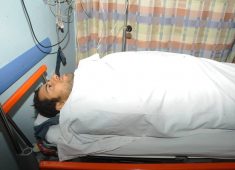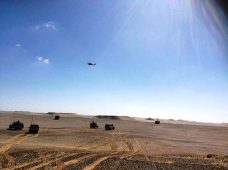
With news being circulated regarding the rescue of the missing police officer Mohamed al-Haies, who had been taken hostage for 11 days by militants following clashes with police forces in the al-Wahat al-Baheira area, many questions are being raised regarding how the rescue operation was conducted.
On Tuesday night, the army’s official spokesperson released two statements that included information on an operation conducted by the Air Force and the the Egyptian army’s elite Thunderbolt force to eliminate a number of militants who participated in the al-Wahat incident.

The first statement described an airstrike that targeted groupings of militants inside a mountainous area to the west of Fayoum governorate close to al-Wahat road. The airstrike led to the destruction of three armored vehicles and militants being killed.
The second statement announced the success of the army operation to free officer al-Haies who had been taken hostage during the al-Wahat military confrontations, which according to official figures, led to the death of 16 servicemen.
The statement was broadcast on video through the official Facebook page of the army spokesperson. The rescue operation was carried out after 11 days of al-Haies having been held hostage.
The rescue operation was conducted by both police and army forces, including the army’s Thunderbolt forces, which appeared in the video statement accompanying al-Haies in a Boeing CH-47 Chinook heavy-lift helicopter.
“The Air Forces received information from the Thunderbolt forces on the stationing points of the militants who are located in a mountainous area west of Fayoum governorate. The kidnapped police officer al-Haies was under strict guardianship from other militants who were away from the air strike,” former chief of staff of Egyptian Army’s elite unit 777 Hatem Saber told Egypt Independent on Wednesday.

He added that the video footage shows that, while missiles were being launched by the Air Force towards the militants on the ground, there were other militants located away from the air strike, stationed behind a hill.
“Those who were located behind the hill were away from the military airstrike that targeted some of them, with the militants who were behind the hill subjecting the police officer Mohamed al-Haies to strict guardianship from the militants” Saber explained.
After the Air Force managed to eliminate a high number of the militants, the Thunderbolt forces started engaging in military confrontations with the remaining militants, one of which started to stab al-Haies in his legs and hands aiming to prevent him from escaping or being rescued, Saber explained.

The Thunderbolt forces managed to kill all of the militants who survived the airstrike and were able to rescue al-Haies from his kidnappers and take him to al-Galaa Military Hospital, he asserted.
As to the time he spent with the militants, al-Haies’ father said in televised statements that his son’s health status is currently stable. However, he is suffering from a shortage of nutrition as he was not allowed to eat for nearly a week.
He added that doctors in the hospital where his son is currently residing told him that he was only drinking 5 cl of water per day and that he is currently receiving hypnotics to sleep.
“He is suffering from severe dehydration — he was handcuffed in the past days,” he said.




